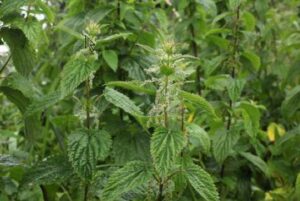
Nettle — Uqaayanaq
Uqaayanat angtaartut. – Nettles are big.
The stinging nettle (Urtica lyalli) grows widely across the northern hemisphere. It thrives in open meadows, flourishes in damp soil, and is found commonly in dense clusters in areas disturbed by human activity. In the Gulf of Alaska, nettles often grow on the surface of archaeological sites-where they prosper in the rich organic soil formed by ancient garbage.
Nettles have distinctive toothed leaves that hold tiny stinging hairs. When broken, these hairs release formic acid, a skin irritant. The Alutiiq word for nettle literally means “something that makes you burn all over.” In the Kodiak area, people often refer to nettles as “burners.” Despite their stinging quality, young nettles are a tasty green vegetable. They are collected in the spring or early summer, boiled for fifteen minutes to remove their bite, and eaten like spinach. Nettles are also used to flavor food. They are added to soups or burned while smoking fish.
Nettles are also widely recognized for their medicinal properties. Nettle leaf tea is said to soothe respiratory problems, particularly tuberculosis, while a tea made from nettle roots can ease the pain of arthritis.
